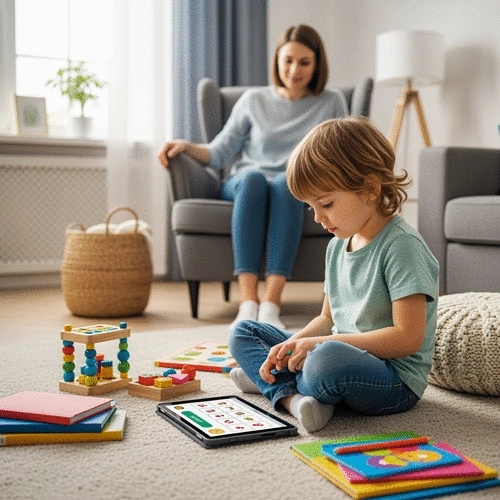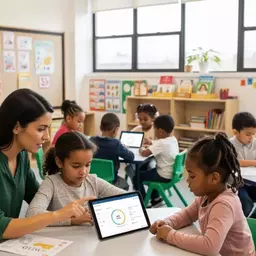In an age where screens dominate our children's environments, understanding how to navigate digital boundaries becomes essential. Consider this: research shows that excessive screen time can impact cognitive, emotional, and social development in young learners. What steps can we take to ensure technology serves as a tool for growth rather than a hindrance? Let's uncover the insights that will empower parents and educators alike.
What You Will Learn
- Set age-appropriate screen time limits to support cognitive, emotional, and social growth.
- Choose high-quality content that is educational and engaging to foster learning.
- Encourage co-viewing and parental involvement to enhance the screen time experience.
- Balance screen time with offline activities to promote physical play and creativity.
Age-Appropriate Screen Time Guidelines
Expert recommendations for daily screen time limits, ensuring a balanced approach to digital media for young children.
Infants (0-18 months)
Avoid use of digital media other than video chatting.
Toddlers (18-24 months)
Introduce high-quality programming with parental guidance, limited to about 30 minutes a day.
Preschoolers (2-5 years)
Limit screen time to 1 hour per day of high-quality content, with co-viewing encouraged.
Understanding the Importance of Digital Boundaries for Early Learners
In today’s world, where screens are a constant presence, it’s crucial to understand the impact of digital exposure on our little ones. As we explore the importance of digital boundaries, we’ll see how screen time affects not just cognitive growth, but also emotional and social development in young children. Have you ever observed how a child interacts differently with a device compared to their peers? This digital interaction can shape their learning experiences! For more on this, consider exploring play-based learning and cognitive growth.
While technology can offer valuable educational content, it's essential to balance it with other experiences. I often encourage parents to think of screen time as just one piece of a much larger puzzle of learning. It’s not just about how much time is spent in front of a screen, but also about what children are doing during that time. Let's delve deeper into why screen time matters!
Why Screen Time Matters in Child Development
The effects of screen time on young children are profound. Research indicates that excessive screen exposure can lead to challenges in areas such as attention span, emotional regulation, and even social skills. Here are some key points to consider:
- Cognitive Development: Limited face-to-face interaction may hinder critical thinking and problem-solving skills.
- Emotional Well-being: Overuse can lead to increased feelings of anxiety and depression.
- Social Skills: Children may struggle with forming connections when relying heavily on screens for interaction.
By understanding these impacts, we can make more informed decisions about screen time and its place in our children's lives. Engaging with our kids during screen activities can also help to mitigate some of these risks! For further insights into emotional development, read about fostering emotional intelligence in kids.
Defining Healthy Digital Habits for Young Children
So, what exactly constitutes healthy digital habits for our young learners? As parents and educators, we play a vital role in establishing these behaviors right from the start. Here are some guidelines to consider:
- Setting Clear Limits: Decide on the appropriate amount of screen time based on age and developmental needs.
- Choosing Quality Content: Focus on educational and interactive materials that promote learning.
- Encouraging Active Engagement: Participate with your children during screen time to enhance their understanding.
By defining these habits early, we can cultivate a healthier relationship with technology. Remember, our involvement is key—children thrive when they know we’re there to guide them!
Setting Age-Appropriate Screen Time Guidelines
As we navigate the landscape of screen time, it’s essential to establish clear and age-appropriate guidelines. The American Academy of Pediatrics has provided valuable insights that can help us set effective limits for our children. After all, we want to ensure they’re getting the best of both worlds—digital learning and real-world experiences!
Recommended Screen Time Limits by Age Group
Based on expert recommendations, here are some suggested screen time limits for different age groups:
- Infants (0-18 months): Avoid use of digital media other than video chatting.
- Toddlers (18-24 months): Introduce high-quality programming with parental guidance, limited to about 30 minutes a day.
- Preschoolers (2-5 years): Limit screen time to 1 hour per day of high-quality content, with co-viewing encouraged.
These guidelines serve as a foundation to help us create a balanced approach to screen use in our homes. Remember, it’s not just about the numbers—it’s about fostering a healthy relationship with technology!
Identifying Quality Content for Young Learners
Choosing the right content is just as important as setting time limits. Not all screen time is created equal! Here are some tips on how to identify quality content for your child:
- Educational Value: Look for programs that encourage critical thinking and creativity.
- Interactive Features: Content that requires active participation can enhance learning.
- Age Appropriateness: Ensure that the material is suitable for your child’s developmental stage.
By focusing on quality content, we can ensure that our children are not just consuming media passively, but are engaging with it in meaningful ways. This engagement can enhance their learning and development!
Understanding Digital Citizenship and Online Safety
As we introduce screens into our children’s lives, it’s vital to talk about digital citizenship and online safety. These concepts are crucial for fostering responsible technology use. Here are some aspects to consider:
- Online Etiquette: Teach children how to interact politely and respectfully online.
- Privacy Awareness: Help them understand what information is safe to share.
- Recognizing Credible Sources: Guide them in distinguishing between reliable information and misinformation.
Fostering digital citizenship isn’t just about keeping our children safe—it’s about empowering them to navigate the digital world responsibly. Let’s equip them with the skills they need to thrive in this new environment! For more parenting tips on emotional growth, visit parenting tips for emotional growth.
Pro Tip
Did you know? Engaging in co-viewing with your child can significantly enhance their understanding and retention of information. By discussing the content together, you not only foster a deeper connection but also encourage critical thinking. Try asking open-ended questions about what they watched to spark a meaningful dialogue!
Frequently Asked Questions About Screen Time
Summarizing Key Takeaways for Healthy Screen Time Practices
As we wrap up our discussion on screen time, it’s essential to highlight the key points that can help us navigate this digital landscape effectively. Establishing healthy digital boundaries is crucial for our children’s development. The main takeaways include:
- Set age-appropriate screen time limits to support cognitive, emotional, and social growth.
- Choose high-quality content that is educational and engaging to foster learning.
- Encourage co-viewing and parental involvement to enhance the screen time experience.
- Balance screen time with offline activities to promote physical play and creativity.
Remember, as parents and caregivers, we play a vital role in guiding our children’s digital experiences. It’s about finding the right balance and staying involved in their online adventures!
Encouraging Ongoing Conversation About Digital Habits
Maintaining an open dialogue about digital habits is essential in today’s fast-paced technological world. I invite you, as parents and caregivers, to keep exploring resources and engaging in discussions around screen time. Here’s how you can foster this ongoing conversation:
- Share tips and strategies with other parents in your community.
- Participate in workshops or online forums related to digital literacy.
- Encourage children to express their feelings about their screen experiences.
- Frequent discussions about content choices can empower your child.
By staying connected and supportive, we can create an informed community that thrives on healthy digital practices!
Call to Action: Download Your Family Media Plan Today
Are you ready to take the next step in managing screen usage at home? I encourage you to download our customizable Family Media Plan. This valuable resource is designed to help you set screen time limits and establish content guidelines tailored to your family's needs. Here’s why you shouldn’t miss out:
- It provides a clear framework for balancing screen time.
- You'll gain insights into selecting age-appropriate content.
- The plan promotes healthy discussions about digital habits.
Let’s work together to create a supportive environment for our little learners. Click the link below to get started on your Family Media Plan today!
Recap of Key Points
Here is a quick recap of the important points discussed in the article:
- Set Age-Appropriate Screen Time Limits: Establish limits based on your child's age to support their cognitive, emotional, and social development.
- Choose High-Quality Content: Opt for educational and interactive materials that encourage learning and engagement.
- Encourage Co-Viewing and Parental Involvement: Participate in your child's screen time to enhance their understanding and make it a shared experience.
- Balance Screen Time with Offline Activities: Promote physical play and creativity by ensuring screen time is complemented with other forms of learning.







